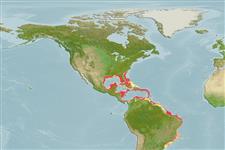Environment: milieu / climate zone / depth range / distribution range
Ecology
Marine; reef-associated; depth range 2 - 150 m (Ref. 5222), usually 2 - 35 m (Ref. 40849). Subtropical; 33°N - 28°S, 98°W - 28°W (Ref. 5222)
Western Atlantic: Gulf of Mexico, Bermuda, Caribbean (mainly insular localities), and Brazil.
Size / Weight / Age
Maturity: Lm ? range ? - ? cm
Max length : 84.0 cm TL male/unsexed; (Ref. 40637); common length : 40.0 cm TL male/unsexed; (Ref. 5217); max. published weight: 10.2 kg (Ref. 40637); max. reported age: 41 years (Ref. 36872)
Dorsal spines (total): 11; Dorsal soft rays (total): 16 - 18; Anal spines: 3; Anal soft rays: 10 - 12. Distinguished by the following characteristics: Tan to brown above, paler below; upper parts of head and most of body usually have small, brown, close-set spots; sometimes uniformly brown. Adults have exerted rays that are even and about equal in length; 23-27 total gill rakers (Ref. 26938); depth of body 3.0-3.4 times in SL; head length 2.8-3.0 times in SL; angular preopercle, enlarged serrae on prominent lobe at the angle and a distinct notch above the serrate lobe; greatly enlarged posterior nostrils in adults (Ref. 89707).
Found mainly on rocky or coral bottoms from the shoreline to at least 55 m depth; small and middle-sized individuals commonly occur in mangrove-lined lagoons. Feeds on fishes. Sex-reversal observed (Ref. 5521). More common in island waters than along the coast (Ref. 26938). The tricolored pattern of the juveniles mimics that of the juveniles of the clown wrasse, Halichoeres maculipinna. The aggressive mimic’s behavior includes folding down the median and caudal fins, which adds to its wrasse imitation and allows it to approach its otherwise wary prey (Ref. 43465). Marketed fresh; flesh is of good quality.
Life cycle and mating behavior
Maturities | Reproduction | Spawnings | Egg(s) | Fecundities | Larvae
Pelagic spawner (Ref. 32199).
Heemstra, P.C. and J.E. Randall, 1993. FAO Species Catalogue. Vol. 16. Groupers of the world (family Serranidae, subfamily Epinephelinae). An annotated and illustrated catalogue of the grouper, rockcod, hind, coral grouper and lyretail species known to date. Rome: FAO. FAO Fish. Synop. 125(16):382 p. (Ref. 5222)
IUCN Red List Status (Ref. 130435)
Threat to humans
Harmless
Human uses
Fisheries: commercial; aquarium: public aquariums
Tools
Special reports
Download XML
Internet sources
Estimates based on models
Preferred temperature (Ref.
123201): 23.3 - 28, mean 26.4 °C (based on 460 cells).
Phylogenetic diversity index (Ref.
82804): PD
50 = 0.5000 [Uniqueness, from 0.5 = low to 2.0 = high].
Bayesian length-weight: a=0.00646 (0.00395 - 0.01056), b=3.05 (2.92 - 3.18), in cm total length, based on LWR estimates for this species & Genus-body shape (Ref.
93245).
Trophic level (Ref.
69278): 4.5 ±0.8 se; based on diet studies.
Resilience (Ref.
120179): Low, minimum population doubling time 4.5 - 14 years (K=0.06; tmax=41).
Fishing Vulnerability (Ref.
59153): High to very high vulnerability (67 of 100).
Nutrients (Ref.
124155): Calcium = 12.7 [7.2, 26.6] mg/100g; Iron = 0.445 [0.222, 0.786] mg/100g; Protein = 19.2 [17.4, 20.9] %; Omega3 = 0.22 [0.13, 0.39] g/100g; Selenium = 20.6 [9.7, 42.8] μg/100g; VitaminA = 86.4 [25.1, 331.4] μg/100g; Zinc = 0.542 [0.353, 0.817] mg/100g (wet weight);
